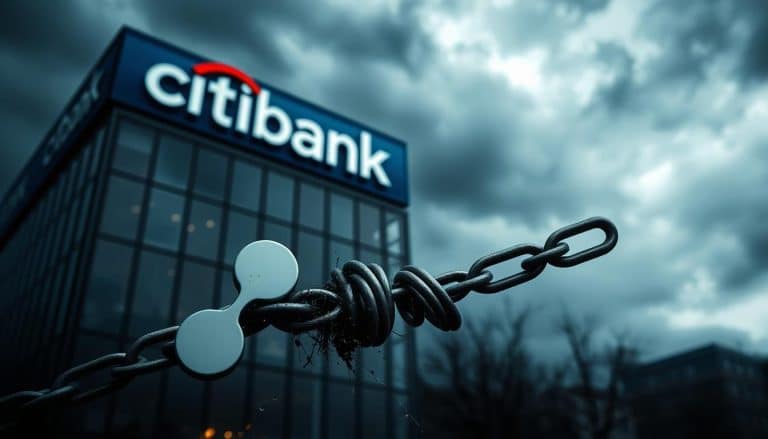Bitcoin vs. Gold in August 2025: Analyzing ETF Flows
Nearly 93% of short positions were eliminated in a single day. This shows how quickly markets can change. Now, everyone wonders if Bitcoin is moving with gold’s ETF flows in August 2025.
The market shifted dramatically. By late August, we saw big moves from short squeezes to hefty investments. BlackRock’s IBIT attracted $116.6M. Ethereum ETFs gathered over $1.0188B. This placed Bitcoin near $120,000 and Ethereum above $4,243, kicking off what may be a bullish phase for Q3 2025.
Meanwhile, the technical and economic aspects of mining were changing. BitMEX Research highlighted the need for more reliable nodes. This is tied to the hash rate from mid-2023 and mining revenue in June 2024. The debate around manual versus automatic node control also stirred. This can impact sentiment and volatility, which in turn, affects ETF flows.
This raises a key question about Bitcoin’s link to gold in August 2025. By examining ETF flows, price, and technical data, we’ll see how institutional moves and infrastructure stories play into the Bitcoin-gold relationship.
Key Takeaways
- Late August 2025 featured major short squeezes and large ETF inflows that shifted market dynamics.
- BlackRock’s IBIT and heavy Ethereum ETF activity signaled rising institutional confidence.
- Node and miner discussions (BitMEX Research) matter—network fundamentals influence price floors.
- ETF flows analysis helps reveal whether Bitcoin moves with or apart from gold in this volatile phase.
- The bitcoin vs. gold August 2025 question is both technical and behavioral—expect mixed signals.
Understanding Bitcoin and Gold Correlation
I watch order books and on-chain flows closely. I see that the link between digital and physical value stores changes often. People often ask how bitcoin and gold are related, especially when the market heats up. Yet, the answer changes based on ETF flows, macro shocks, and network upgrades. I base my view on tracking price action, what big investors do, and debates about node software.
Historical Context of Bitcoin and Gold
At first, Bitcoin was seen as a speculative tech asset. In 2013 and 2017, it followed risk appetite, not acting like a safe haven. After big losses, some started viewing BTC as a digital gold. This idea caught on a bit, but it didn’t completely change how the asset is viewed.
Large narrative shifts happened when big players entered the scene. Companies like Grayscale and Fidelity, along with new exchange-traded products, changed perceptions. These events are key when looking at how gold and bitcoin prices move together over time.
Recent Trends in Correlation
Up to 2025, correlation patterns between bitcoin and gold changed. High bitcoin volatility often meant it moved independently from gold. But during big economic shocks, both sometimes gained value. The takeaway: short-term correlation fluctuates, while long-term correlation varies by economic situation.
Market moves, like short squeezes and big ETF buys, have sometimes brought bitcoin and gold closer. The market structure also matters. For example, how Bitcoin trades near important price points can affect its movement compared to gold.
Factors Influencing Correlation Today
Several factors drive changes in their relationship. Store-of-value views can bring bitcoin and gold closer. Market mood swings, like risk-seeking or avoiding, can pull them apart. Big investments through ETFs link them by moving money into both.
How well Bitcoin’s network works is also key. Improved infrastructure boosts confidence in Bitcoin. Efforts like those by BitMEX Research to improve node reliability can stabilize the market. When Bitcoin seems less risky, its movement with gold can become more similar.
Debates about bitcoin’s technical future can also impact its relation to gold. Current talks about node software may cause bitcoin to temporarily move differently from gold, especially when ETFs are heavily involved.
| Driver | Effect on bitcoin correlation with gold | Observable Signal |
|---|---|---|
| Institutional ETF inflows | Increases co-movement as cash allocates across both | Net flows, fund filings, large block trades |
| Risk-on/Risk-off regimes | Reduces correlation during risk rallies; raises it in panic | VIX spikes, equity drawdowns, flight-to-safety bids |
| Network infrastructure improvements | Can raise correlation by lowering BTC idiosyncratic risk | Hash rate trends, client adoption, node stability reports |
| Technical market structure | Alters short-term coupling through leverage and squeezes | Key price levels, RSI, futures open interest |
| Regulatory clarity | Supports institutional bids and sustained correlation | ETF approvals, SEC guidance, custody frameworks |
I often wonder if bitcoin will keep correlating with gold into August 2025 due to ETF flows. The true answer is it depends on new cash flows, market details, and overall economic mood. It’s better to watch for the signals mentioned above than to focus on one correlation measure.
Overview of ETF Flows in August 2025
In August 2025, I saw a big change in where institutions put their money. There was a lot of interest in crypto ETFs and gold funds. This caught the eye of asset managers and university endowments as they planned their strategies.
Big investments changed the game. For example, Harvard put $116.6M into BlackRock’s IBIT. On August 11, there were inflows of over $1B into Ethereum ETFs. These numbers highlight the strong interest in crypto and gold.
Current State of Bitcoin ETFs
In August, interest in Bitcoin ETFs grew fast. This was due to short squeezes and clear signals of improving regulation. BitMEX Research mentioned better infrastructure and clearer rules helped a lot.
Different Bitcoin ETFs saw different amounts of money coming in. For instance, IBIT received $116.6M from institutional investors. Other ETFs also had net positive inflows, showing both buying and trading.
Current State of Gold ETFs
Gold ETFs kept attracting investors looking for safe options. Funds like SPDR Gold Shares and iShares Gold Trust were popular. This helped gold ETFs do well in August 2025.
Some investors stayed with gold while also getting into crypto. This dual approach shows it’s not simple to compare the two. Each investor’s goals can vary.
Comparison of Inflows and Outflows
When we compare net flows, differences and overlaps become clear. Crypto ETFs saw big investments and rapid interest. Gold ETFs had steady inflows but with a different rhythm and scale.
| Fund Type | Representative Funds | Notable Flows (Aug 2025) | Flow Character |
|---|---|---|---|
| Bitcoin ETFs | BlackRock IBIT, Fidelity FBTC | $116.6M (Harvard into IBIT) + multiple institutional buys | Concentrated institutional accumulation, episodic surges |
| Ethereum ETFs | Various spot Ether ETFs | $1.0188B on Aug 11 (aggregate inflows) | Large single-day inflows, high momentum interest |
| Gold ETFs | SPDR GLD, iShares IAU | Steady net inflows across month; persistent demand | Consistent safe-haven buying, lower volatility in flows |
| Net Flow Dynamic | Cross-asset comparison | Crypto surged episodically; gold had steady inflows | Rotation and parallel allocation both observed |
Looking at ETF flows in August 2025, there was interest in both gold and crypto. This shows investors had different reasons, like diversifying or seeking risk. The relationship between bitcoin and gold was multi-layered in August.
Some investors moved from cash or short positions to crypto. Meanwhile, others kept or increased their gold holdings. The dynamics between bitcoin and gold in August showed overlapping yet different goals among investors.
Key Statistics and Graphs
I guide readers through August 2025’s key stats with easy-to-follow visuals. We will compare prices, ETF flows, and on-chain data side by side.
Bitcoin Price Trends in August 2025
Bitcoin’s price hovered around $120,000 by late August. The market’s health, indicated by an RSI around 63 and a 20-day moving average of about $120,000, looks positive. A Fibonacci extension hints at a potential rise to $131,000.
But it wasn’t all smooth sailing. A major surge knocked out over 92% of short positions in a day. With up to $18 billion at stake from a 10% price move, areas below $115,700 are key for strategic entries.
Gold Price Trends in August 2025
Gold played its part in calming the market, unlike the more volatile equities and crypto. Market trends for gold followed central bank updates and real yield changes closely. Charts showing day-to-day data reveal the switches between gold and crypto ETF investments.
For more on how asset interplay affects prices, see my analysis on gold’s impact on bitcoin: gold rally analysis.
Visualizing ETF Flow Data
To highlight the stats, I recommend three visual aids. First, a daily overlay of BTC versus gold in August, noting when ETF money moved. Then, a look at ETF net flows for the month in stacked bars. Lastly, a rolling correlation heatmap for 30, 60, and 90 days showcasing how relationships shift with market events.
Extra charts might show trading volumes on Binance, plus mining revenues and hash rates. These help explain the market forces influencing prices.
| Chart | Key Metrics | What to Look For |
|---|---|---|
| BTC vs. Gold Daily Overlay (Aug 2025) | BTC price, Gold price, Annotated ETF inflow dates | Price divergence, simultaneous inflows, and reversal points |
| Net ETF Inflows/Outflows (Stacked Bars) | BTC ETF net flows, Gold ETF net flows, Daily volume | Flow dominance, timing of large buy/sell days, liquidity shifts |
| Rolling Correlation Coefficient (30/60/90) | 30-day, 60-day, 90-day correlation between BTC and gold | Correlation spikes during short-liquidation events and ETF surges |
| Short-Liquidation Bar Chart | Percent of shorts wiped, $ value liquidated, event timestamp | Magnitude of squeezes, cluster timing vs. ETF inflows |
| On-Chain & Market Liquidity Panel | Hash rate trend, historical mining revenue, exchange BTC volumes | Supply pressure, miner sell behavior, exchange liquidity impact |
Predicting Future Market Trends
I explain possible futures for bitcoin and gold clearly. I link ETF flows, on-chain data, and other indicators. These include ETF weekly changes, inflation reports, and miner activity.
My analysis covers three key areas: market dynamics, tech improvements, and monetary policy. I predict a bull market in Q3 2025, influenced by institutional buyers and market trends. Bitcoin’s trajectory could rise if trends continue, raising questions for traders.
I offer different future scenarios for investors to consider. Each one is based on specific, observable events that happen regularly.
- Bull continuation: ETF inflows boost BTC. Demand from institutions and node efficiency strengthen its market position. BTC might then align more with stocks than gold. Indicators include ETF inflows and exchange data.
- Rotation to safe havens: Events or Fed actions shift investments to gold. BTC experiences outflows and aligns closer with gold temporarily. Signs include inflation surprises and rapid investment changes.
- Mixed regime: Investors hedge by putting money in both BTC and gold. Their relationship can vary based on investment strategy and liquidity needs.
BitMEX Research notes node reliability supports BTC ETFs long-term. This suggests BTC could move away from gold with more institutional interest. But, upgrades disputing within the community pose risks of market swings.
Global events affect these predictions. Hopes for peace in Ukraine, U.S. inflation data, and Federal Reserve’s stance could alter investor behavior quickly. Keep an eye on the broad economic indicators and liquidity to guide immediate decisions.
Here’s a concise forecast: short-term, bitcoin may differ from gold in August 2025. Long-term ties depend on global shocks and how fast institutions adopt. I link each outcome to data so readers can track updates directly.
Factors Affecting Investment Decisions
I track flows and mood every week. ETF net flows, on-chain metrics, and macro headlines guide how I adjust exposure to both assets. They shape investor sentiment for Bitcoin and gold in different ways.
I watch liquidity events closely. In August 2025, explosive short liquidations and big institutional inflows lifted confidence. For example, Harvard’s $116.6M IBIT placement was a key move. Technical momentum, like an RSI near 63, boosts optimism among momentum traders. I’ve observed tactical re-entries under $115,700.
Network reliability is key for longer-term investments. BitMEX Research shows that easy custody and stable node operations lower institutional barriers. This makes the infrastructure feel more reliable, improving risk assessments. It helps shift investor sentiment for Bitcoin towards a buy-and-hold strategy.
Gold is influenced by macro risks and shocking news. In August 2025, geopolitical improvements nudged capital into riskier assets, reducing the safe-haven demand for gold slightly. Yet, gold ETFs like GLD still attract defensive flows during inflation or when monetary uncertainty is high. This keeps gold closely linked to macro and political uncertainties.
Geopolitical changes can quickly redirect flows. Risk-off moments caused by news send money into gold. Flash events, like protocol changes or forks, can make BTC prices very volatile. I watch geopolitical events and on-chain reserve levels to identify shifts.
Here are the practical heuristics I use when making allocation calls:
- Monitor ETF net flows weekly for directional bias.
- Check exchange balances and miner selling to measure supply pressure.
- Use technical support and resistance to size entries against volatility.
- Weigh macro indicators and the influence of geopolitical events before shifting defensive posture.
| Factor | Bitcoin Signal | Gold Signal |
|---|---|---|
| ETF Net Flows | Large institutional inflows raise investor sentiment Bitcoin; volume confirms trend | Positive flows during risk spikes boost gold investor sentiment; defensive demand rises |
| On-Chain Metrics | Falling exchange reserves and reduced selling pressure support bullish cases | Not applicable directly; ETFs and physical holdings matter more |
| Technical Momentum | RSI ~63 signals room for trend-followers to add positions | Momentum less pronounced; trend follows macro shock |
| Infrastructure & Custody | Improved custody lowers friction and helps institutional adoption | Custody mature; storage and ETF mechanics are stable |
| Geopolitical Events | Protocol stress or regulatory shocks can trigger >20% intraday swings | War and inflation fears shift capital into gold; reflects gold market trends |
Tools for Tracking Bitcoin and Gold Markets
I keep a few tools handy for tracking bitcoin and gold markets. They let me follow bitcoin prices and check gold ETF flows. I aim to match on-chain info with usual market tools. This way, I spot trends before others see them.
Recommended Market Analysis Tools
I use Glassnode, Chainalysis, and Coin Metrics for insights. They provide info on exchange reserves, miner income, and risks of short positions.
To understand network security, I check out BitMEX Research and sites like BTC.com. They show what miners are doing and explain supply changes.
For ETFs and market trends, I look at Bloomberg and Yahoo Finance. I also check ETF.com and filings from iShares and BlackRock. Websites like ETF Flow help me match daily flows with price moves.
How to Use Tracking Tools Effectively
I set alerts for big ETF filings and disclosures. Alerts help me see where money is really going.
I use tools to compare bitcoin with gold over time. I combine ETF flows with price charts for a clearer picture.
Building a watchlist, I mix price charts, on-chain info, and ETF data. This helps me get into positions smarter and manage risks.
Resources for Real-Time Data
For quick market snapshots, I use Binance and Coinbase. They offer up-to-date info on sudden market changes.
I keep an eye on Bloomberg Terminal for macro updates and gold ETF news. Fast updates from Twitter/X help me check facts quickly.
For dashboards, I pull data from APIs of on-chain services and exchanges. This gives me real-time alerts and helps me track bitcoin and ETF trends easily.
Frequently Asked Questions
I often receive questions weekly about tracking markets. People are curious about how bitcoin, gold, and ETF activity interact. I strive to keep my answers concise, useful, and based on real-time observations.
How Are Bitcoin and Gold Valuations Related?
Comparing prices, the connection varies with the market’s state. At times, bitcoin moves alongside stocks, acting as a risk asset. Other times, it aligns more with gold, becoming a value store. In August 2025, certain factors like technical squeezes and significant ETF inflows shaped bitcoin’s price.
Factors such as short liquidations can temporarily separate BTC from gold. I observe how their relationship changes by watching market trends and sudden changes in price movement.
What are the Risks of Investing in ETFs?
First, consider tracking errors and liquidity issues. ETFs aim to replicate an index, yet sometimes there’s a difference in performance.
For cryptocurrency ETFs, the security of holdings and network stability are crucial. The foundation of an ETF can be affected by miners and custody solutions. Regulatory changes can also suddenly alter the landscape, despite increasing trust among institutions.
Why Should Investors Watch ETF Flows?
ETF flows show how investors are moving their money. I look at these flows to decide when to buy or sell. Large inflows increase demand, while outflows can push prices down.
In August 2025, more people were investing in cryptocurrency ETFs, making it clear why these trends are important. Reports on daily and weekly flows help predict market movements, giving an early glimpse into investment trends.
Evidence of Bitcoin-Gold Relationship
I track markets like a mechanic tunes an engine. August 2025 revealed clues about the connection between BTC and gold. I’ve laid out the evidence for readers to see the link for themselves.
Academic studies on correlation
Academic studies usually focus on price movements to find correlation. But they often overlook on-chain factors that are crucial for Bitcoin. BitMEX Research suggests that network improvements alter BTC’s core attributes in ways that research must consider.
Studies that include factors like hash rate and transaction volume offer a comprehensive outlook. I’ve seen cases where adding these elements to models changed the findings of correlation studies.
Real-world examples of ETF performance
In August 2025, we saw distinct impacts from ETF activities. Harvard IBIT reported a significant $116.6M in institutional inflows. This coincided with short squeezes and sudden increases in BTC price, illustrating how ETF movements can influence Bitcoin differently from gold.
Past debates over Bitcoin’s protocol have also caused dramatic swings. For instance, discussions in 2017 and during the Bitcoin Unlimited era led to over 20% price fluctuations. Similar events and ETF activities in August 2025 led to BTC moving differently again.
Key takeaways from recent data
Correlation changes over time and depends on various factors. The most accurate tests combine price trends with ETF inflows, short squeezes, and network metrics like hash rate.
To understand if bitcoin moves with gold, look at specific periods. Sometimes they move closely together. Other times, they diverge due to ETF actions or updates in Bitcoin’s protocol.
| Evidence Type | Illustrative Metric | What it Reveals |
|---|---|---|
| ETF inflows | $116.6M IBIT inflow (Aug 2025) | Big buys from institutions can amplify BTC’s price movements, making it temporarily drift from gold |
| Short-liquidation events | Magnitude of squeeze during inflow episodes | Shows how market structure can create volatility, not just economic factors |
| Network fundamentals | Hash rate trends, exchange reserves | Indicates growing confidence among institutions and a change in volatility patterns |
| Historical protocol disputes | 2017 fork volatility, Bitcoin Unlimited era | Examples of >20% swings that caused temporary separation from other assets |
Trustworthy Sources for Investment Research
When researching ETF flows, I start with primary documents and top outlets. BlackRock and Fidelity updates, along with SEC documents on EDGAR, give clear insights. They show real allocations and any official changes, focusing on IBIT. For fast news on flows and big changes, I count on Bloomberg, Reuters, and CoinDesk. They help me confirm the details and when they happened.
For detailed tech studies, I turn to specialized groups and sites. BitMEX Research and Glassnode offer deep looks into the tech side, including how nodes and mining are doing. Coin Metrics and Arcane Research add insights with data from Blockchain.com or BTC.com. These experts make the data easier to use for investment choices.
I also get numbers straight from official filings like 13F, Form N-PORT, and reports from sponsors. Info from ETF sponsors and custody papers is critical for double-checking. My method is straightforward: use SEC filings, blockchain analysis, and news. Then, add in big-picture views from the Bureau of Labor Statistics and the Federal Reserve. This gives a complete view.
This approach is part of my daily routine. By mixing original sources, blockchain info, and professional research, I get a better understanding. Especially on how bitcoin acts compared to gold, or if it’s on a unique path. For solid research, base your work on these reliable sources. And always confirm your findings.








 Bitcoin
Bitcoin  Ethereum
Ethereum  Tether
Tether  XRP
XRP  USDC
USDC  TRON
TRON  Lido Staked Ether
Lido Staked Ether  Dogecoin
Dogecoin  Figure Heloc
Figure Heloc  Cardano
Cardano  WhiteBIT Coin
WhiteBIT Coin  Bitcoin Cash
Bitcoin Cash  Wrapped stETH
Wrapped stETH  Wrapped Bitcoin
Wrapped Bitcoin  USDS
USDS  Wrapped eETH
Wrapped eETH  Binance Bridged USDT (BNB Smart Chain)
Binance Bridged USDT (BNB Smart Chain)  Chainlink
Chainlink  Monero
Monero  LEO Token
LEO Token  WETH
WETH  Zcash
Zcash  Stellar
Stellar  Coinbase Wrapped BTC
Coinbase Wrapped BTC  Ethena USDe
Ethena USDe  Litecoin
Litecoin  Hyperliquid
Hyperliquid  Avalanche
Avalanche  Sui
Sui  Hedera
Hedera  sUSDS
sUSDS  Shiba Inu
Shiba Inu  Dai
Dai  USDT0
USDT0  Canton
Canton  PayPal USD
PayPal USD  Toncoin
Toncoin  Uniswap
Uniswap  World Liberty Financial
World Liberty Financial  Cronos
Cronos  Ethena Staked USDe
Ethena Staked USDe  Mantle
Mantle  USD1
USD1  Polkadot
Polkadot  Rain
Rain  Bitget Token
Bitget Token  MemeCore
MemeCore  Tether Gold
Tether Gold